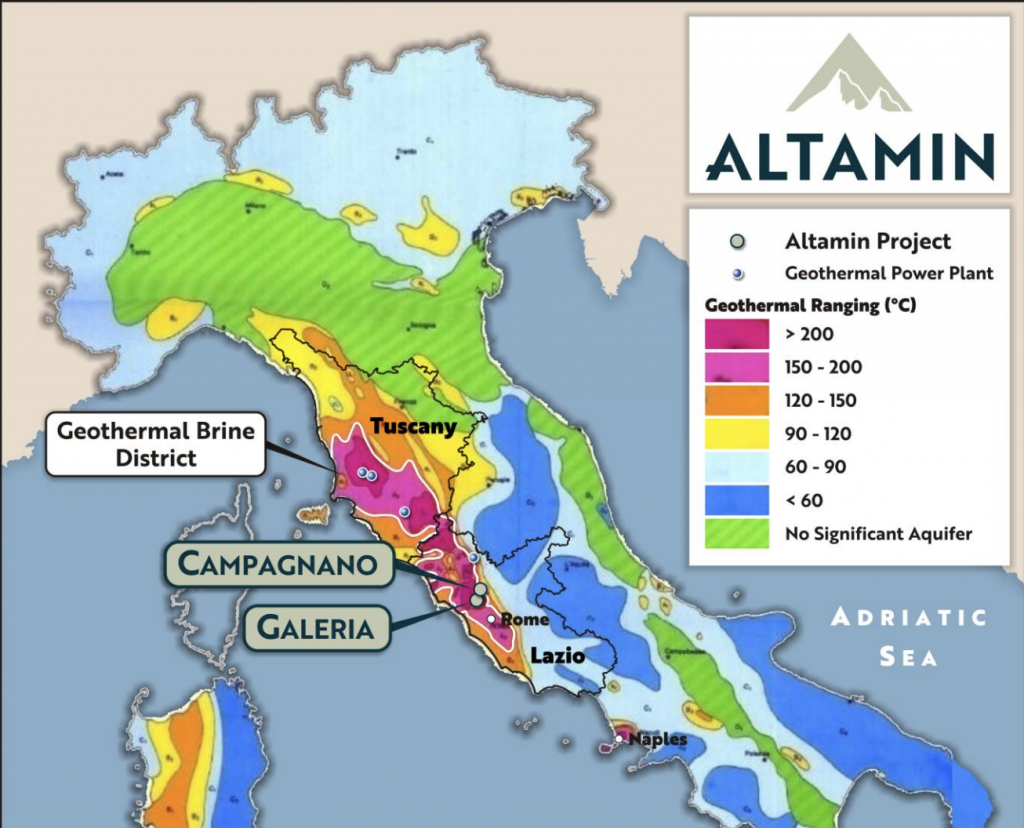Mining firm seeks exploration licenses for geothermal lithium in Italy
Mining company Altamin (listed on the ASX) has applied for exploration licenses in Italy targeting extraction of lithium from geothermal brines.
Australian Stock Exchange listed mining company Altamin has announced applications for two exploration licences (ELs) in the Lazio administrative region of central Italy. Altamin owns the historic Gorno Zinc Project located in the Lombardia region of northern Italy and has a portfolio of other mineral exploration projects in northern Italy and Australia.
The exploration licenses (EL) soguht are highly prospective for lithium in geothermal brines and are located at Cesano, about 50km north of Rome. Exploitation of high-temperature geothermal waters for electricity production is a mature and well understood industry in Italy which started at the beginning of the 20th century in Tuscany, to the north of the ELs under application.
The geothermal systems of Tuscany and Lazio are amongst Italy’s most prospective (see picture above) and from the mid-1970s through to the 1990s more than 800 geothermal wells were drilled mainly in the southern part of Tuscany and northern part of Lazio, including in the ELs under application.
The average depth of the wells is far below potable water sources, at about 2,000m, and in some cases over 4,000m and this historical drilling is expected to provide an important source of information for project evaluation. In the location of the EL applications the reservoirs are dominated with high salinity brines (with correspondingly high mineral content) and the reservoirs remain unexploited for geothermal power with the historical data indicating an immediate opportunity for lithium.
Brines in the Cesano area contain significant and elevated lithium values, and early studies conducted in the 1990s suggest the potential feasibility of lithium recovery from these fluids. Test Well Cesano C1 (Figure 2) yielded brines from a depth of 1,390m with a lithium content of 350 mg/l and 380 mg/l. For comparison, this exceeds the average 200 mg/l lithium concentrations of the brines of the Salton Sea geothermal field in California which is regarded as the most significant lithium brine resource in the USA.
Geothermal lithium is the focus of Alta’s proposed exploration in the Cesano district within the following two ELs (Figure 2):
- The Campagnano EL, of about 1,200 hectares, includes one test well and lies contiguous to, and immediately north and east of an EL granted to Vulcan Energy Resources (ASX: VUL). Vulcan’s core focus is to produce lithium from geothermal brines in the Upper Rhine Valley of Germany and their recently granted EL highlights a new prospective venture into Italy; and
- The Galeria EL, of about 2,040 hectares, covers an area some 10km to the south of Campagnano, and includes one geothermal well and two test wells.
If successfully granted the EL’s initial work program will be to obtain and assess the historical geological and technical data from the geothermal wells on the property, including well C-16. Also, to assess the feasibility of resampling and full analysis of the geothermal brines from existing well-holes. Lithium is included, along with cobalt, in the list of 30 critical materials prepared by the European Union for their economic importance and supply risk. Lithium-rich geothermal brines represent an untapped potential resource that can potentially be developed into a valuable supply in Europe. The production techniques for extraction of lithium from geothermal brines are evolving towards commercialisation and the high geothermal gradients present on the ELs under application could assist in meeting some or all of the energy requirements for this process.
Application for these prospective lithium in brine licences is in alignment with Alta’s strategy to identify and secure value accretive projects for commercialisation by leveraging its unique exposure to the under-explored mineral potential in Italy. If approved, these lithium ELs will take their place in Alta’s growing pipeline of base and battery metals projects strategically situated in the heart of Western Europe close to prospective partners, financiers and within easy logistical reach of the downstream consumer market. Alta’s key focus remains the development and continued exploration of its flagship Gorno Zinc Project, where Definitive Feasibility Study work has commenced and diamond drilling of step-out and in-fill targets will restart shortly upon completion of the current rights issue.
Source: Company release (pdf)


















